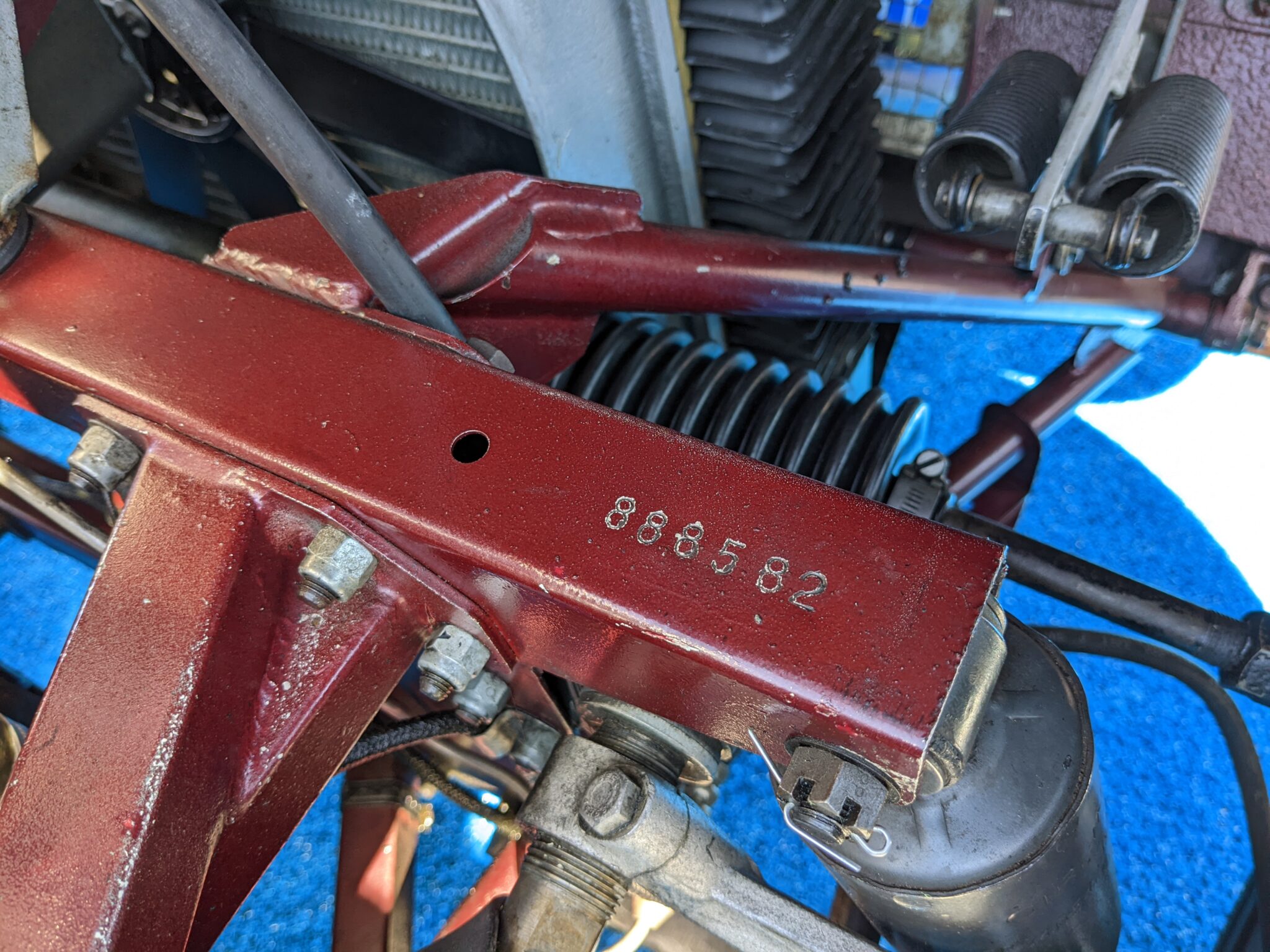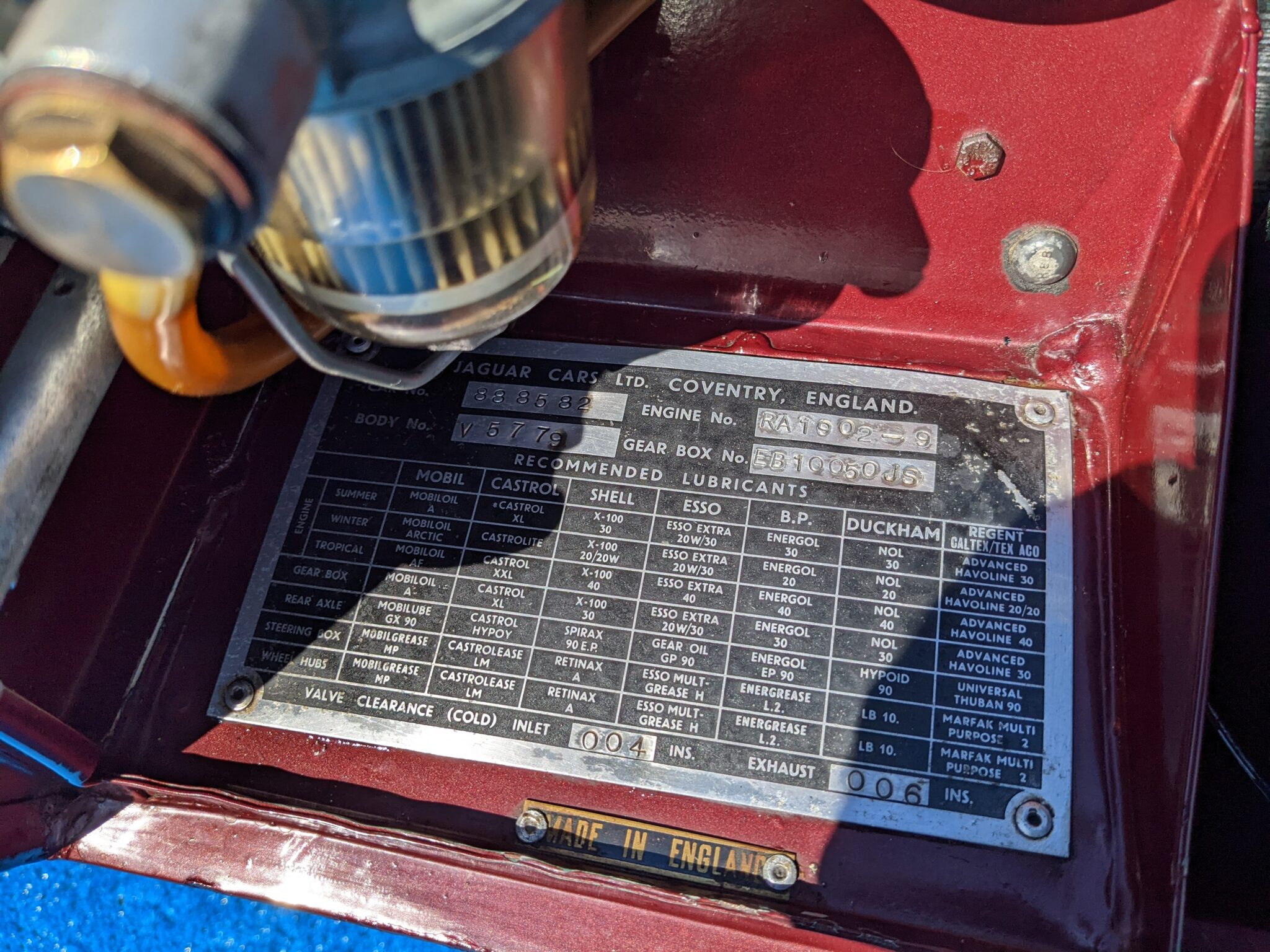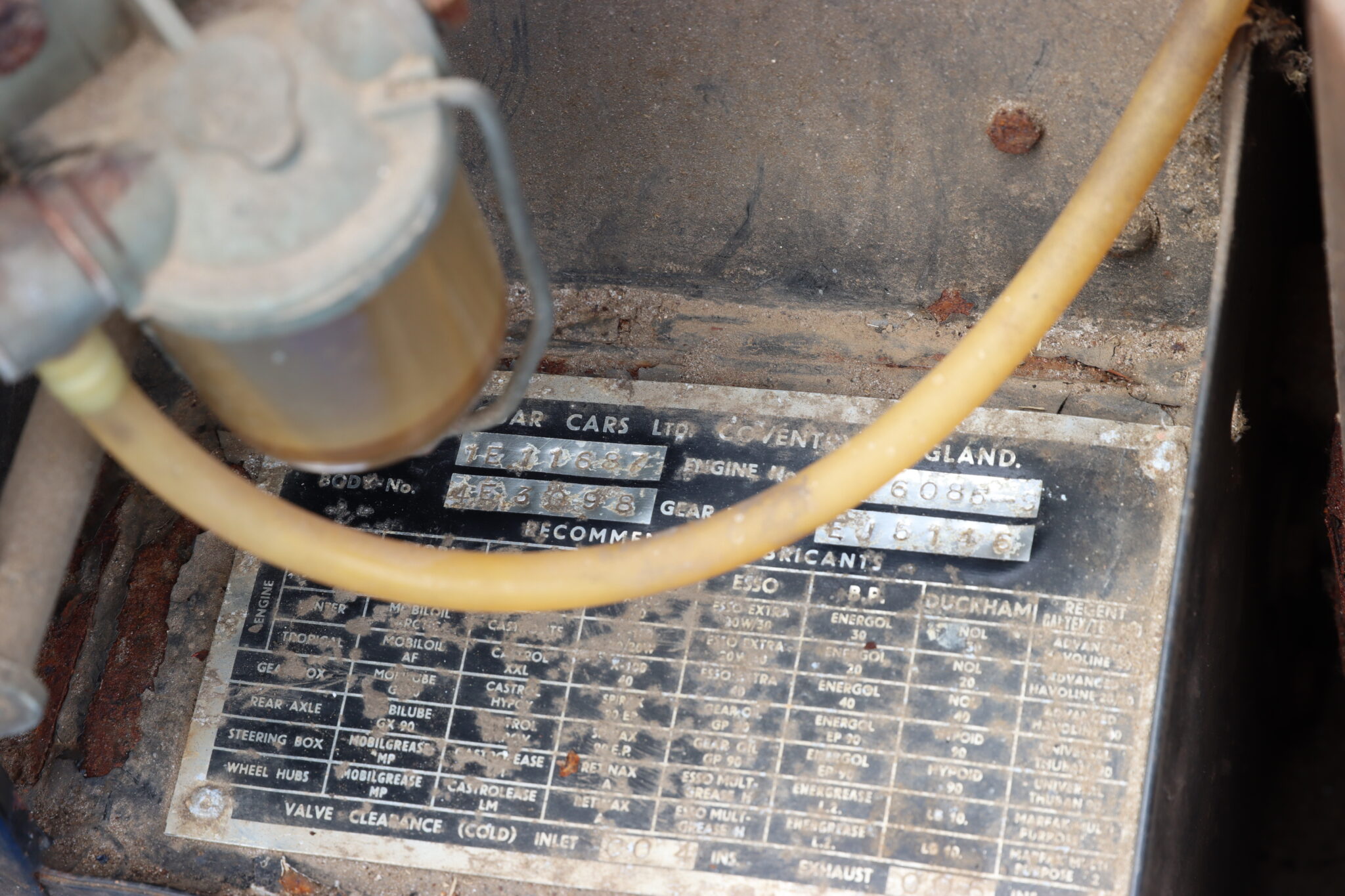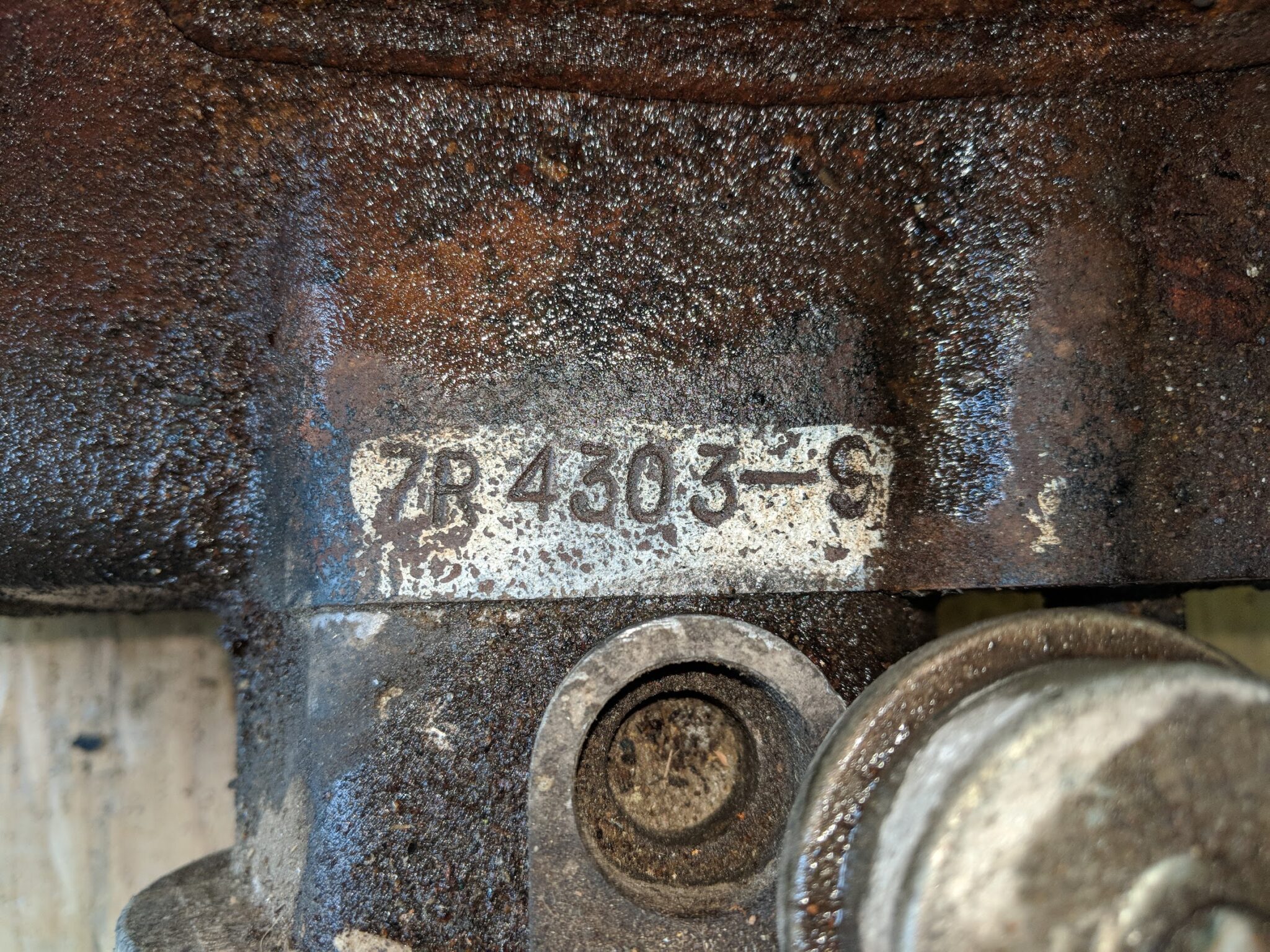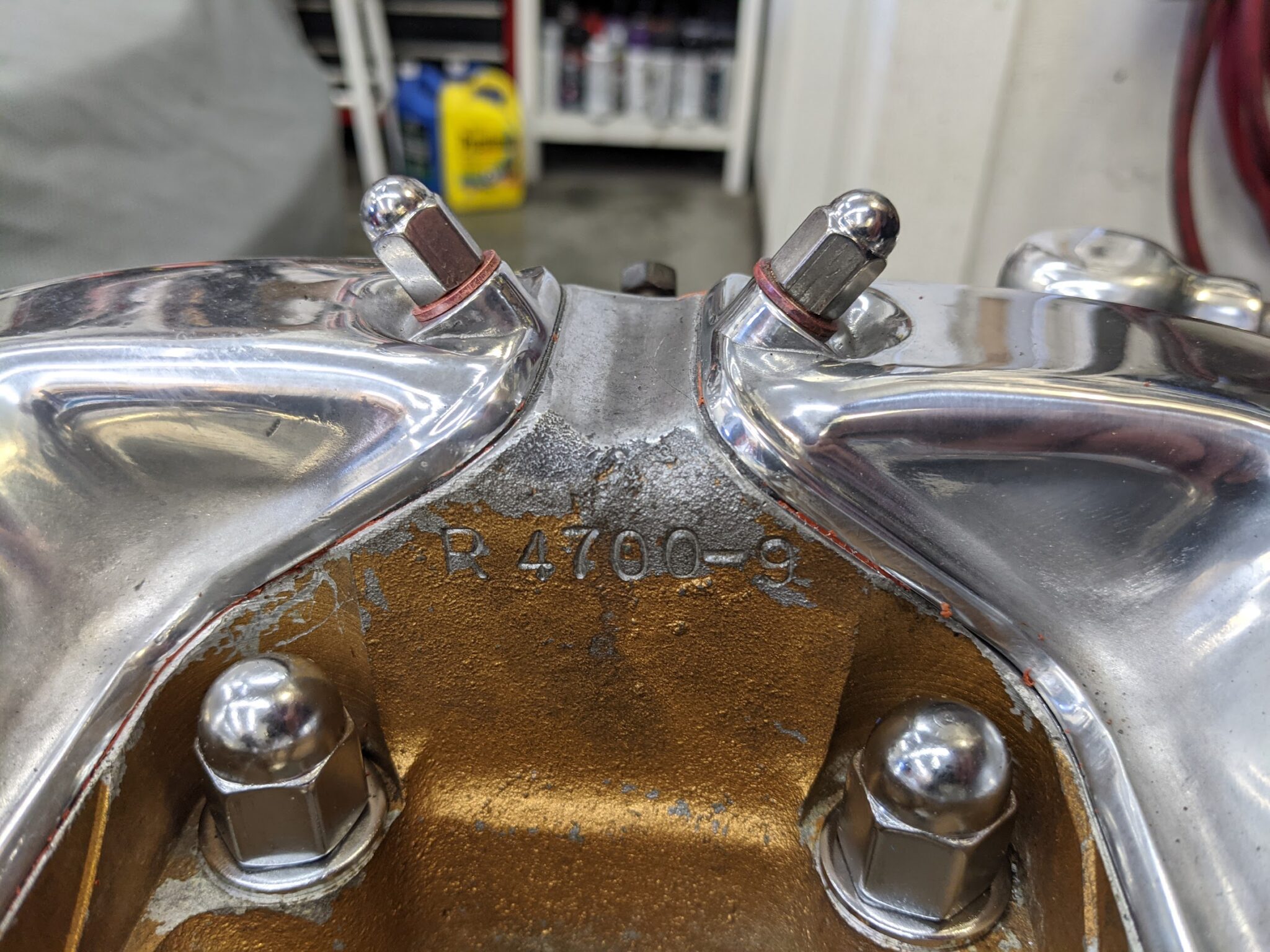Jaguar E-Type Chassis, Body, Engine Numbers 1961-1971 by Richard Michael Owen
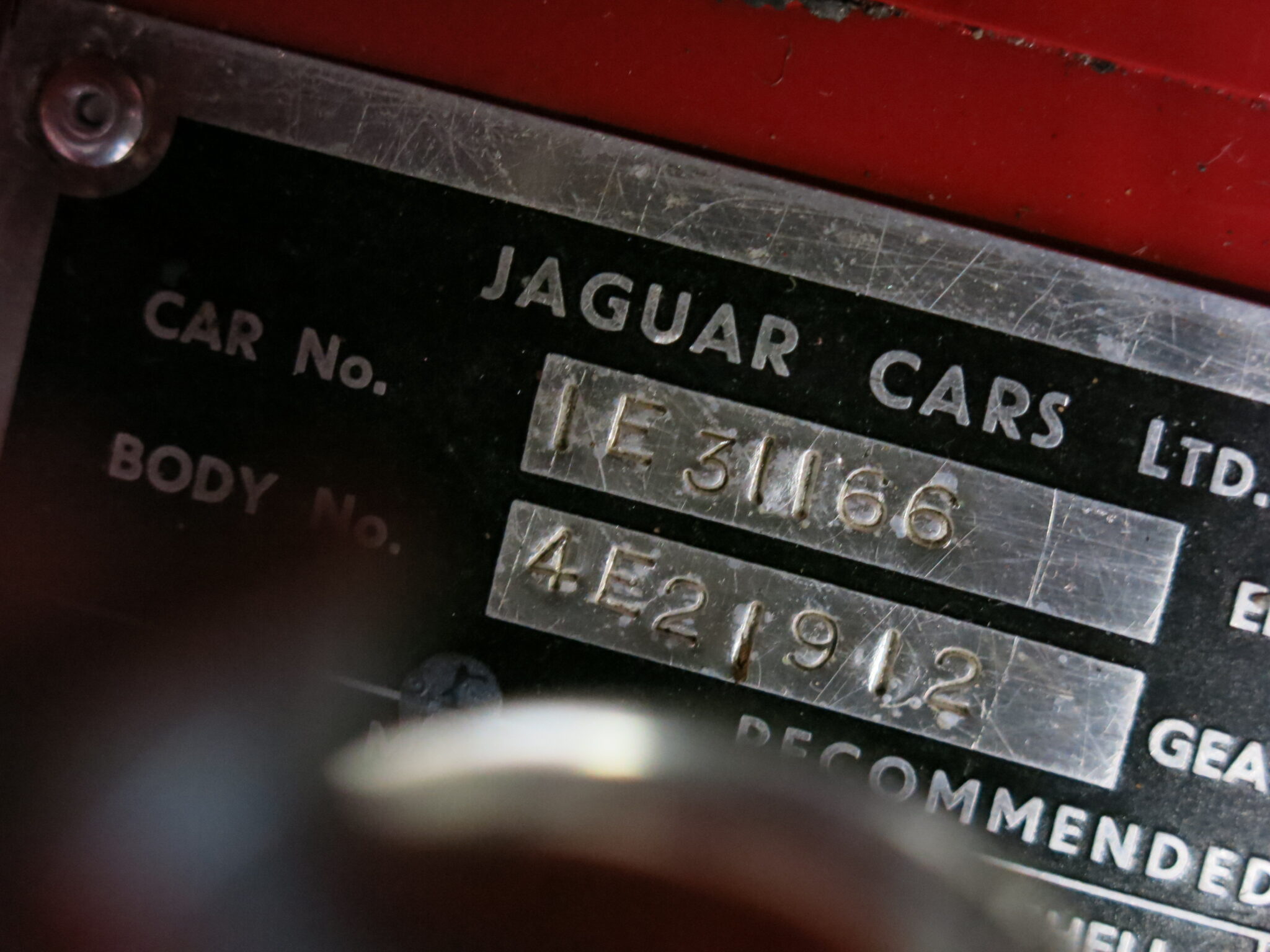
This document shows factory production data for the Jaguar E-type Series 1 model in both 3.8 and 4.2-litre configuration as well as Jaguar E-type Series 2 4.2-litre compiled by the author and Jaguar Daimler Heritage Trust. It includes details on first chassis numbers by year for right-hand drive (RHD) and left-hand drive (LHD) models, and is divided into open two-seater (OTS) and fixed-head coupes (FHC) and 2+2.
Many countries titled cars on date of import instead of date produced, including USA and Canada which were often one-year out. Many documents such as Certificate of Title, Vehicle Ownership or Registration Certificate can mismatch date of manufacture.
Furthermore the state of California added a J-Tag near the chassis tag and prefixed cars J62, J63, J64, J65, J67, J68, J69 depending on year of import. For example the above car could have been registered J651E31166 or J661E31166 in the state of California. French import cars had an additional tag mounted on the RHF firewall.
Each body type has an independent linear sequence which means the number indicated only specifies the production within a particular type. Using our example chassis tag above, car 1E31166 is the 1166th LHD FHC produced with the OTS having a separate sequence. With this system is is possible for many cars to share the same number with a different prefix.
To get an accurate Heritage Document on the production data of any Jaguar a formal request can be to be submitted to the Jaguar Daimler Heritage Trust https://www.jaguarheritage.com/
Jaguar E-type Series 1 3.8 (15,496 produced)
- 3.8 Engine Number Prefixes:
- First engines have prefix R starting from 1001
- From February 1963 onwards RA prefix beginning from 1001
- Stamping is found on the engine block near the oil filter adapter, in the valley on the cylinder head, flywheel and crankshaft.
- Most cars were suffixed 9 for 9.0:1 compression and some rare 8.0 and 7.0 cars were produced.
- 3.8 Body Number Prefixes:
- For the open two-seater (OTS) models, body numbers start with R.
- For the fixed-head coupe (FHC), body numbers start with V.
- Body numbers begin at 1001.
- Early Cars can often have mismatched body numbers, tags and stampings that are close within the range
- Early Cars have bonnet stamping on the RH bonnet side stiffener.
- Body number was often hand written with a grease pen/crayon on the front engine firewall, middle or side of the bonnet, backside of the dashboard near the glovebox, under original upholstery like the boot cover, floor mats, interior trim
- Body tags were riveted on various locations of the body before paint, including the RHF engine firewall, LHR interior trunk and behind the license plate.
- 3.8 Production Chassis Numbers:
- Chassis number is stamped on the chassis tag also known as the commission plate and on the LH side of the engine subframe known as the picture frame near the top shock absorber mount
- Total of 15,496 3.8 E-Types produced.
- The following table lists the 3.8-litre starting chassis numbers for each model year:
| Year | OTS RHD | OTS LHD | FHC RHD | FHC LHD |
| 1961 | 850001 | 875001 | 860001 | 885001 |
| 1962 | 850328 | 876471 | 860134 | 885399 |
| 1963 | 850646 | 878863 | 861052 | 888035 |
| 1964 | 850808 | 880808 | 861434 | 889752 |
| Last | 850943 | 881886 | 861799 | 890872 |
| Total Production | 942 | 6885 | 1798 | 5871 |
In January 1962, E-Type production had a major body revision including a new dished floor panel also known as a heel well that was a considerable upgrade. Floor assemblies changed from BD15171 to BD23141 and these cars came with longer clutch pedal, longer brake pedal and revised carpet to match. Around this same time the bonnet louvres becoming integral instead of a welded insert panel.
Earlier cars became known as Flat Floor with a total of 2616 flat floor cars with breakdown as as follows:
| Flat Floor Production | OTS RHD | OTS LHD | FHC RHD | FHC LHD |
| Final Flat Floor | 850357 | 876581 | 860175 | 885503 |
| Total Flat Floor | 357 | 1581 | 175 | 503 |
Around May/June 1962 it is important to note that Jaguar completely revisited the component level body production for all cars to ramp up production. Many sub-assembles switched suppliers, such as Pressed Steel to Abbey Panels for the FHC rear hatch. This revision started with chassis 850527/860581/877356/886093.
This large production revision outlined a specific body structure that would not change in any major capacity until 1971 with the introduction of the LWB S3 V12 model. This mid-1962 change point is when the monocoque and engine subframes were sufficiently modified for strength and passenger comfort.
E-Type floors and sills were modified and most notably, twin dished recess panels were included in the rear bulkhead behind seats. These work in conjunction with modified seat tracks that allow 1.5 inches of extra legroom.
Along with the dished rear firewall, the lightweight Reynolds 531 bonnet subframe featured larger gussets and the floor section was also modified with new jacking points and sills.
During this period the FHC received entirely new rear bodywork including rear fenders, rear boot hatch, rear boot hatch glass, rear boot prop rod, tail panel, fuel filler flap and rear signal light bases. This had the negative effect of limiting the first 1,491 coupes, or 13.6% of total production to different rear boot hatch metalwork and glass. FHC bodywork changed around coupe 860478/886013:
| Early FHC Body | RHD | LHD |
| Last Early FHC Body Made | 860478 | 886013 |
| Total Early FHC Body | 478 | 1013 |
Jaguar E-type Series 1 4.2 (22,916 produced)
- 4.2 Engine Number Prefixes:
- Engine number prefix: 7E with numbers starting from 1001.
- 2+2 models start from 5000.
- 4.2 Body Number Prefixes 4E:
- 1001 for open two-seaters (OTS)
- 20001 for fixed-head coupes (FHC)
- 50001 for two-plus-two (2+2) models
- 4.2 Production Chassis Numbers:
- same as 3.8 for location and type
- Automatic 2+2 cars featured suffix BW for Borg Warner
| Year | OTS RHD | OTS LHD | FHC RHD | FHC LHD | 2+2 RHD | 2 + 2 LHD |
| 1964 | 1E/1001 | 1E/10001 | 1E/20001 | 1E/30001 | ||
| 1965 | 1E/1078 | 1E/10441 | 1E/20139 | 1E/30454 | 1E/50001 | 1E/75001 |
| 1966 | 1E/1435 | 1E/12348 | 1E/21155 | 1E/32474 | No record | 1E/75010 |
| 1967 | 1E/1705 | 1E/14472 | 1E/21473 | 1E/34072 | 1E/50676 | 1E/76986 |
| 1967 S1.5 | 1E/1864 | 1E/15980 | 1E/21584 | 1E/34583 | 1E/50975 | 1E/77709 |
| 1968 S1.5 | 1E/1995 | 1E/16653 | 1E/21744 | 1E/34984 | 1E/51117 | 1E/77860 |
| Last | 1E/2183 | 1E/18367 | 1E/21958 | 1E/35814 | 1E/51379 | 1E/79221 |
| Total Production | 1182 | 8366 | 1957 | 5813 | 1378 | 4220 |
| S1.5 Production | 320 | 2479 | 375 | 1565 | 404 | 1577 |
Jaguar E-type Series 2 4.2 (18,808 produced)
- 4.2 Series 2 Engine Number Prefixes:
- Engine number prefix: 7R with numbers starting from 1001
- 2+2 models from 35001
- later cars had no cylinder head stamping and instead only one number on the LHR of the engine block
- USA delivery cars featured double stromberg carberutors one of three variations of secondary intake manifolds.
- 4.2 Series 2 Body Number Prefixes 4R:
- 1001 for open two-seaters (OTS)
- 20001 for fixed-head coupes (FHC)
- 35001 for two-plus-two (2+2) models
- 4.2 Series 2 Production Chassis Numbers:
- Some late cars designated for the US market and marked as 1971 model year have a prefix 2R instead of 1R, these featured a revised evap system with charcoal canister C32827.
| Year | OTS RHD | OTS LHD | FHC RHD | FHC LHD | 2+2 RHD | 2+2 LHD |
| 1968 | 1R/1001 | 1R/7001 | 1R/20001 | 1R/25001 | 1R/35001 | 1R/40001 |
| 1969 | 1R/1075 | 1R/8126 | 1R/20127 | 1R/25601 | 1R/35119 | 1R/40799 |
| 1970 | 1R/1499 | 1R/12201 | 1R/20605 | 1R/27572 | 1R/35697 | 1R/43437 |
| Last | 1R/1776 | 1R/14853 | 1R/21071 | 1R/28786 | 1R/36041 | 1R/44287 |
| Total Production | 775 | 7852 | 1070 | 3785 | 1040 | 4286 |
- Sources & Further Information
- Michael Mueller & Dr Thomas F. Haddock. (2017). Jaguar E-Type Six-Cylinder Originality Guide. Dalton Watson Fine Books.
- Malcom McKay. (2021). Original Jaguar E-Type. Porter Press International
- Jaguar Daimler Heritage Trust. (2012). First Chassis by Year Records.
- Stew Cleave. (2006). JCNA Model Year ’68 E-Type Judges Guide. JCNA
